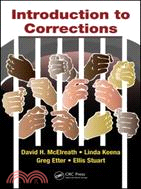相關商品
商品簡介
作者簡介
目次
商品簡介
Millions in our nation are under some type of judicial sanction, with some individuals behind bars but the majority serving their sentences while living and working among us. Introduction to Corrections examines predominant issues related to the system of administering to offenders in the United States. Written in a simple, concise style and enhanced with discussion questions and a list of key terms in each chapter, this volume begins with an overview of the system and a historical review and then focuses on select issues, including:
Sentencing goals and rationales, and types of sentencing
Noncustodial supervision, including probation, electronic monitoring, home confinement, halfway houses, and offender registration
Parole and postconfinement release
Jail, prison, and jurisdictional differences in correction systems
Challenges faced by corrections personnel, including overcrowding, health issues, sexual assault in institutions, and prison gangs
Constitutional challenges to inmate controls
Issues related to victims’ rights, including federal and state funds and notification programs
Correctional counseling perspectives and prevailing sociological theories
Controversies surrounding capital punishment in the United States
Juvenile corrections, including probation, parole, and life sentences for minors
The evolution of corrections in the United States has spanned three centuries and has moved from an origin of basic community-based confinement to an extensive system that includes federal, state, local, private, and military facilities and programs. Examining diverse topics relevant to a range of professionals in the corrections community, this book explores the functions of corrections as well as those who serve in the profession.
Sentencing goals and rationales, and types of sentencing
Noncustodial supervision, including probation, electronic monitoring, home confinement, halfway houses, and offender registration
Parole and postconfinement release
Jail, prison, and jurisdictional differences in correction systems
Challenges faced by corrections personnel, including overcrowding, health issues, sexual assault in institutions, and prison gangs
Constitutional challenges to inmate controls
Issues related to victims’ rights, including federal and state funds and notification programs
Correctional counseling perspectives and prevailing sociological theories
Controversies surrounding capital punishment in the United States
Juvenile corrections, including probation, parole, and life sentences for minors
The evolution of corrections in the United States has spanned three centuries and has moved from an origin of basic community-based confinement to an extensive system that includes federal, state, local, private, and military facilities and programs. Examining diverse topics relevant to a range of professionals in the corrections community, this book explores the functions of corrections as well as those who serve in the profession.
作者簡介
David H. McElreath, PhD, has served as professor and chair, Department of Legal Studies, the University of Mississippi; professor and chair, Department of Criminal Justice, Washburn University; associate professor, Southeast Missouri State University; assistant professor, the University of Southern Mississippi; instructor, Itawamba (Mississippi) Community College; colonel, U.S. Marine Corps; and he has held law enforcement and corrections positions with the Oxford (Mississippi) Police and Forrest County (Mississippi) Sheriff’s Departments. His education and training include a PhD in adult education and criminal justice, University of Southern Mississippi; an MSS, U.S. Army War College; MCJ, the University of Mississippi; BPA, the University of Mississippi; and he is a graduate of the U.S. Army War College. He is also the author or coauthor of numerous textbooks and publications on the criminal justice and homeland security systems.
Linda Keena, PhD, obtained her BCJ (1984) and MS (1991) degrees in criminal justice from Southeast Missouri State University, and her PhD (2006) from the University of Missouri. She is a former State of Missouri adult probation and parole officer and has taught in the Department of Criminal Justice and Sociology at Southeast Missouri State University, and most recently in the legal studies department at the University of Mississippi. She has established a record of scholarly publications that reflects a variety of criminal justice, restorative justice, religion, corrections, and community-based research topics. In addition, she is coauthor and project director for MEDFELS, a nationally recognized methamphetamine program for elementary schools. Dr. Keena is codirector of the Violence Prevention Office at the University of Mississippi, a program funded by the Office on Violence Against Women, U.S. Department of Justice, aimed at educating students and staff about the realities of sexual assault, relationship violence, and stalking.
Greg Etter, EdD, is an assistant professor of criminal justice at the University of Central Missouri. He retired as a lieutenant with the Sedgwick County Sheriff’s Office in Wichita, Kansas, after 29 years of service. He is rated as a gang expert by the National Gang Crime Research Center in Chicago, Illinois. Dr. Etter’s educational background includes BS and MS degrees from Wichita State University, and he earned his doctorate from Oklahoma State University. He is a member of the National Sheriff’s Association, American Jail Association, American Correction’s Association, Academy of Criminal Justice Sciences, and the American Society of Criminology. He is the author of a textbook on hate crimes and numerous journal articles. Dr. Etter has presented papers and conducted law enforcement and corrections training all over the United States and Canada.
Ellis Stuart Jr. has served as director of public safety for the City of Hazlehurst, Mississippi; contract agent for the Mississippi Metro Narcotics Task Force, chief of police for the City of Greenwood Mississippi, director of public safety for the Mississippi University for Women, hearing officer for the Mississippi Parole Board, probation and parole officer for the Mississippi Department of Corrections, youth court counselor for the Mississippi Department of Youth Services, and juvenile planner for the Law Enforcement Administration Division, Mississippi Office of the Governor. Mr. Stuart’s education and training include a master’s degree in criminal Justice from Mississippi Valley State University, a bachelor’s degree in social and rehabilitation services from the University of Southern Mississippi, and he is a graduate of the Mississippi Law Enforcement Officers Academy, Mississippi State Fire Academy, and FBI National Academy. Mr. Stuart is currently serving as the Copiah County (Mississippi) coroner.
Linda Keena, PhD, obtained her BCJ (1984) and MS (1991) degrees in criminal justice from Southeast Missouri State University, and her PhD (2006) from the University of Missouri. She is a former State of Missouri adult probation and parole officer and has taught in the Department of Criminal Justice and Sociology at Southeast Missouri State University, and most recently in the legal studies department at the University of Mississippi. She has established a record of scholarly publications that reflects a variety of criminal justice, restorative justice, religion, corrections, and community-based research topics. In addition, she is coauthor and project director for MEDFELS, a nationally recognized methamphetamine program for elementary schools. Dr. Keena is codirector of the Violence Prevention Office at the University of Mississippi, a program funded by the Office on Violence Against Women, U.S. Department of Justice, aimed at educating students and staff about the realities of sexual assault, relationship violence, and stalking.
Greg Etter, EdD, is an assistant professor of criminal justice at the University of Central Missouri. He retired as a lieutenant with the Sedgwick County Sheriff’s Office in Wichita, Kansas, after 29 years of service. He is rated as a gang expert by the National Gang Crime Research Center in Chicago, Illinois. Dr. Etter’s educational background includes BS and MS degrees from Wichita State University, and he earned his doctorate from Oklahoma State University. He is a member of the National Sheriff’s Association, American Jail Association, American Correction’s Association, Academy of Criminal Justice Sciences, and the American Society of Criminology. He is the author of a textbook on hate crimes and numerous journal articles. Dr. Etter has presented papers and conducted law enforcement and corrections training all over the United States and Canada.
Ellis Stuart Jr. has served as director of public safety for the City of Hazlehurst, Mississippi; contract agent for the Mississippi Metro Narcotics Task Force, chief of police for the City of Greenwood Mississippi, director of public safety for the Mississippi University for Women, hearing officer for the Mississippi Parole Board, probation and parole officer for the Mississippi Department of Corrections, youth court counselor for the Mississippi Department of Youth Services, and juvenile planner for the Law Enforcement Administration Division, Mississippi Office of the Governor. Mr. Stuart’s education and training include a master’s degree in criminal Justice from Mississippi Valley State University, a bachelor’s degree in social and rehabilitation services from the University of Southern Mississippi, and he is a graduate of the Mississippi Law Enforcement Officers Academy, Mississippi State Fire Academy, and FBI National Academy. Mr. Stuart is currently serving as the Copiah County (Mississippi) coroner.
目次
Section I: Foundations of CorrectionsAn Overview of CorrectionsCorrectional FoundationsThe Global CommunityCrimeHow Do We View Corrections?What Is Corrections?A Snapshot of Those Adults Confined and Under Judicial SanctionsJuvenile OffendersProfessional Opportunities in CorrectionsWhat Is the Goal of Corrections?Corrections: A Historical ViewFoundation for Institutional Corrections and the Rule of LawEnglandEarly Prison Reform and ReformersDevelopment of the American Prison SystemThe Penitentiary in America: New-Gate, Walnut Street Jail, and the Early Efforts to Develop PrisonsThe Reform EraEmergence of the National Prison AssociationEarly Steps in Federal ConfinementEarly 1900sThe Industrial EraEarly Twentieth-Century Correctional Leaders and the Concept of PrisonizationRiots, Litigation, and ReformA New Era in CorrectionsSentencingSentencing Goals and RationalesTypes of SentencesSentencing ModelsSentencing DisparitySection II: Community CorrectionsHistory and Process of Probation and Noncustodial SupervisionOverview of Noncustodial SupervisionProbationHistory of ProbationFoundations of Federal Probation and Pretrial ServicesThe Probation ProcessOffender AssessmentElectronic MonitoringIntensive Supervision Probation (ISP)Community CorrectionsDay and Evening Reporting CentersHome Confinement ProgramsResidential Reentry Centers or Halfway HousesOffender RegistrationCorrectional TreatmentTermination of Probation and Noncustodial SupervisionHistory and Process of Parole and Postconfinement ReleasePostconfinement Release OptionsFoundations of the Concept of ParoleOverview of Parole in the United StatesHistory of Parole in the United StatesParole Differs From ProbationParole Boards and Parole SelectionOther Factors Influencing the Awarding of ParoleProcess of Parole and Postconfinement SupervisionTermination of Parole or Postconfinement ReleaseSection III: Institutional CorrectionsJailsThe GaolThe Advent of the JailComing to JailThe Garage Sally PortBooking/IntakeInmate ClassificationHow Inmate Classification WorksInmate HousingInmate SupervisionWork Release ProgramsInmate HealthcareInmate ProgramsManaging a JailJail OvercrowdingThe Jail as a Place of ExecutionCorrectional Systems and InstitutionsTypes of Correctional Systems and InstitutionsLocal CorrectionsState CorrectionsFederal CorrectionsPrivate CorrectionsMilitary CorrectionsJuvenile CorrectionsPrison LifeStaff: Managing the PrisonersCorrectional OfficersThe Role of the Corrections OfficerCorrectional Officer AssignmentsGenderCorrectional Officer PowerTraining of Correctional PersonnelAdministering Inmate Rehabilitation ProgramsInmate World: Living Behind BarsThe Inmate SubcultureSocial StructureHow Does It Form? Prison Social Structure and the Inmate CodeMale Prison SexualityInmate Suicide and PrisonMentally Ill InmatesAging OffendersA Society of Violent MalesThe Radicalization of Male Prison InmatesFemale InmatesCritical Needs in Dealing With Female InmatesFemale Prison SexualityFemale Inmate Suicide and Self-MutilationSection IV: Issues in CorrectionsCurrent Issues and Problems Facing CorrectionsFundingPersonnel Recruitment, Training, and AccreditationOvercrowding of InstitutionsHealth, Medical, Mental Health, and Substance Abuse TreatmentHealth Issues: HIV/AIDS, Tuberculosis, and HepatitisDrug and Alcohol TreatmentSexual Offender Treatment ProgramsAging Offender PopulationViolence and Sexual Assault in InstitutionsPrison GangsWomen in PrisonPrivatizationInmate LitigationBreaking the Cycle of RecidivismInmate Rights and Correctional LawHistory of Correctional LawInmate Access to the Courts (First Amendment)Inmate Mail and Other Communications (First Amendment)Religion (First Amendment)Visitation and Association Rights of Inmates (First Amendment)Search, Seizure, and Inmate Privacy (Fourth Amendment)Inmate Discipline and Due Process (5th and 14th Amendments)Other Due Process Issues: Classification, Transfers,Personal Injuries, and Property Loss (5th and 14th Amendments)Conditions of Imprisonment: Cruel and Unusual Punishment (Eighth Amendment) Health Care (Eighth Amendment)Female Inmates and Other Special Inmate Populations (14th Amendment)Inmate LaborVictims’ RightsHistory of the Crime Victims’ Movement in the United StatesTypes of VictimsCosts That Crime Victims SufferThe Role Correctional Agencies Play in Meeting Victims’ NeedsCorrectional CounselingDefining Correctional TreatmentInstitutional Versus Community-Based Correctional Treatment SpecialistsCustodial Staff Versus Correctional Treatment StaffTheoretical Counseling PerspectivesGroup Versus Individual CounselingCapital PunishmentMethods of Execution Used in the United StatesHistory of the Death Penalty in the United StatesFurther Evolution of the Death Penalty in the United StatesOld Sparky: Texas Prison MuseumThe Move to Eliminate Capital PunishmentDeath Penalty in the United States after GilmoreExecution and GenderCapital Punishment: Jurisdictional ViewIssues in Capital PunishmentJuvenile CorrectionsJuvenile CrimeWho Is the Juvenile Offender?The Juvenile SystemBalanced and Restorative Justice and the Juvenile OffenderJuvenile Corrections: A Historical GlanceJuvenile Institutions, Detention, and Residential ConfinementSheltered Care Facilities and Community Residential FacilitiesCase Management and SupervisionJuvenile Justice IssuesJuvenile Probation, Parole, and AftercareLife Without Parole for JuvenilesInterstate Compact on JuvenilesIndex
主題書展
更多主題書展
更多書展本週66折
您曾經瀏覽過的商品
購物須知
外文書商品之書封,為出版社提供之樣本。實際出貨商品,以出版社所提供之現有版本為主。部份書籍,因出版社供應狀況特殊,匯率將依實際狀況做調整。
無庫存之商品,在您完成訂單程序之後,將以空運的方式為你下單調貨。為了縮短等待的時間,建議您將外文書與其他商品分開下單,以獲得最快的取貨速度,平均調貨時間為1~2個月。
為了保護您的權益,「三民網路書店」提供會員七日商品鑑賞期(收到商品為起始日)。
若要辦理退貨,請在商品鑑賞期內寄回,且商品必須是全新狀態與完整包裝(商品、附件、發票、隨貨贈品等)否則恕不接受退貨。
























